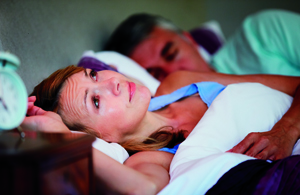Getting a good night's sleep is good for your health
3/10/2025 by Meghna Mansukhani, M.D.

You toss and turn. Your partner snores. The dog takes up too much of the bed. Events of the day plague your dreams. You wake up groggy and dull, hoping a cup of coffee will jump-start your system. A poor night's sleep may make your day sluggish, but a poor sleep pattern can affect your health.
Why is sleep so important?
People spend one-third of their lives sleeping, restoring their bodies and mind to function well during the day. The amount of sleep people get is just as significant as the quality. While the quantity of sleep needed to feel rested and function well during the day varies from person to person, the American Academy of Sleep Medicine recommends a minimum of seven hours for adults. Less than five hours of sleep per night has been associated with higher mortality, cancer risks and adverse effects on heart health.
What does a typical night's sleep look like from a scientific standpoint?
Sleep comprises alternating rapid eye movement (REM) and non-REM sleep cycles. Each cycle lasts about 90 minutes. As the night progresses, the amount of REM increases. This is when people experience vivid dreaming, accounting for about 20%–25% of total sleep.
Experts don't know precisely why REM sleep is essential, but they theorize that during REM sleep, people learn or unlearn information gathered during the day. Think of it as the brain creating new work files and deleting unnecessary ones.
So, how do people improve the quality of their sleep?
They start by prioritizing sleep and creating an environment and schedule conducive to sleep. Try these techniques if you have difficulties sleeping:
- Try to keep the same schedule every day, particularly waking up at the same time, even on weekends and on vacation. If you have trouble falling asleep, delay bedtime until you feel drowsy.
- Try not to spend more than eight hours per day in bed.
- Make sure where you sleep is dark, quiet, and not too hot or too cold. Wear comfortable clothing.
- Work regular physical activity into your day but refrain from exercising four to six hours before bedtime.
- Limit caffeine to two servings daily and drink those before noon.
- Avoid electronics, screens or anything mentally stimulating, like an exciting movie or book, before bedtime.
- Save your bed and bedroom for sleeping and sexual activity
- Limit napping to 30 minutes a day, ideally before early afternoon.
On those nights when you have difficulty falling or staying asleep, don't watch the clock. If you're not feeling sleepy or can't get back to sleep, after about 15 to 20 minutes, get up and do something boring, like reading a dull book.
If you've fallen into a pattern of poor sleep, one of these conditions may be the culprit:
- Insomnia, where you cannot fall asleep or stay asleep.
- Restless legs syndrome, where your legs feel fidgety or twitchy.
- Sleep apnea is when you stop breathing and wake up gasping and choking.
These conditions — or just feeling like you're not getting sufficient sleep — may indicate the need for a sleep consultation and treatment. As researchers learn more about sleep disorders, new therapies are being developed, such as insomnia medications, implantable devices for sleep apnea and different medications for restless legs syndrome.
People function better and lead healthier lives when they're well-rested. If you're concerned about the quality of your sleep, contact your care team.
Meghna Mansukhani, M.D., is a Pulmonary Medicine and Family Medicine physician. She is the former co-director of the Center for Sleep Medicine, director of the Sleep Medicine Fellowship Program at Mayo Clinic in Rochester and regional chair of research and innovation for Mayo Clinic Health System in Southwest Minnesota. She is the director of Academic Advancement and Promotions for Midwest Family Medicine at Mayo Clinic. Dr. Mansukhani has also recently was president of the Minnesota Sleep Society and chair of the American Academy of Sleep Medicine's Education Committee.
